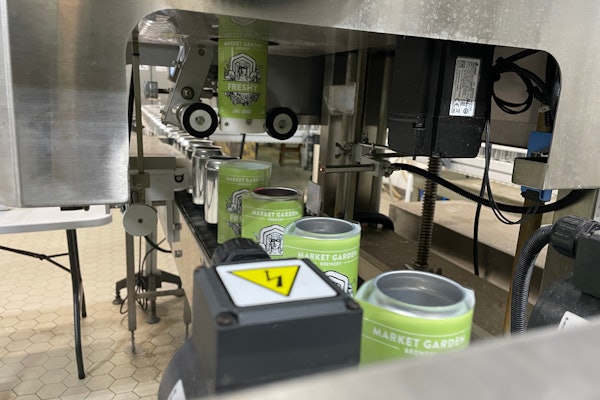More than ever, manufacturing’s role in the company’s supply chain is critical for reliably delivering on its customer requirements, consumer expectations, and financial performance. Market conditions have created a tsunami of special deviations from the norm for manufacturing.
And while consumer packaged goods (CPG) manufacturing professionals are committed to delivering for their stakeholders in the face of these deviations, the most challenging question facing them is how to ensure that their operations are the strongest link in their supply chain.
This article focuses on four critical factors in strengthening your supply chain: integrated business planning (IBP), reliability engineering and asset optimization, Industry 4.0 digital insights, and transformational OEM relationships. To address each, in turn, FSO Institute has sought the insights of industry subject matter experts Jon Doering, senior vice president supply chain, DecoPac; John Robertson, vice president life cycle engineering; Bob Gates, senior director, GE Digital; and Paul Schaum, partner + coach, FSO Institute.
FSO Institute: Jon, you have always been a strong advocate for integrated business planning. You have described it as necessary to link the “how we go to market,” forecasts, and the ability of the business to supply. How would you recommend a consumer products company pursue IBP?
Jon Doering: IBP’s power enables month-to-date business performance discussions, evaluation of performance against overall business enterprise objectives, and EBITDA performance. This is crucial information for leadership. So, whether it be in my current role or prior leadership roles, when considering IBP, I have always started with the following questions:
- What is the current state of the business and why?
- Do we have the long-term visibility to future business initiatives and expected outcomes?
- Do we have facts and options to change the first two questions?
Previously, in meetings with my fellow leadership team, we were working to understand and solve for what we perceived as “present time issues” when we could and should have seen them months prior or at the onset of our strategic planning process. The recognition of need for integrated business planning lies within your reflection and ability to understand how you are operating today vs. how you need to operate tomorrow to maintain relevancy in the market.
Today might look like the following if you reflect on the state of your business:
- Reactive mode
- Lack of correlation of business information and impact to business
- Lack of financialization of business changes
- The need for structure and KPIs that drive discussion through all feeder meetings and IBP process meetings
- Lack of executive summary narratives that drive thought and understanding of the business
By installing an IBP process and a culture of empowerment, you will find yourself with a team that not only shows up to a meeting but has given thought to the state of the business and is prepared to contribute to conversation in a way that can shape the growth of the business. You will also find that your business has transformed and provides information that your business can make decisions from, such as the following:
- Providing better cost-benefit analysis to risks and opportunities that drives improved business decision-making
- Securing capacity to deliver business growth and meeting customer service expectations
- Measuring performance to drive improvement
- Easier and more efficient translation of information across functional areas (marketing, sales, operations, and finance)
- Improving trust throughout the team with one process and clear accountabilities
FSO Institute: Life Cycle Engineering’s expertise in reliability engineering is well known. What would you suggest to minimize the supply chain risks to manufacturing in the food and beverage industry?
John Robertson: The current supply chain issues, lack of a skilled/motivated workforce, coupled with growing demand, substantially increases risks for food and beverage manufacturers.
To minimize these risks, leaders need to build a smart culture promoting the application of proactive asset management best practices while embracing technology and innovation.
When engaged employees apply reliability and operational excellence processes to manufacturing assets, they minimize risks by increasing availability, production rate, and quality while ensuring regulatory compliance. This improvement in plant performance can also increase the level of attraction and retention of a more productive workforce. Engaging teammates in proactive asset management also results in extended asset life and an increase in shareholder return.
FSO Institute: Given the pervasive discussions around Industry 4.0, how would you suggest a manufacturer start taking advantage of 4.0 to fortify its supply chain?
Bob Gates: Supply chain issues can disrupt business when lacking digital insight on the network. Industry 4.0 can drive agility as it is key to making sure the supply chain is robust. Robust in the past was focused on what was on hand in the warehouse. As inventories shrink, the need to understand the factory floor becomes even more important for avoiding stockouts. Industry 4.0 drives companies to pull their data together and apply better intelligence against the data, enabling better forecasting and real-time adjustments to meet business needs.
FSO Institute: Paul, when you were the CTO of Pretzels Inc., how did you overcome the supply chain crisis when you were adding new production lines into the plant?
Paul Schaum: Partnering with key OEMs has value. Are they going to pull out all the stops when a crisis hits? The best example is when we ran into electronic component supply issues which could cause multiple months’ delay on equipment delivery and start-up. The OEM told us the situation and then went about finding alternate solutions.
The first thing they did was search the world for alternate parts. Their next step was to purchase the entire electrical stock of a used electronics parts supplier. The used parts could be used in the new equipment with spare used parts as backup for start-up. Then when the new parts were available, they would be swapped out and all new machine warranties would be intact. This resulted in one production line starting on time and the second production line having only a six-week delay.
Fortifying your supply chain is reliant upon your company’s manufacturing health. Beginning with a strategic imperative as IBP, managing risk through asset optimization, developing digital insights to your manufacturing performance, and strengthening your partnering relationships with suppliers have proven to be a strong path forward.


























